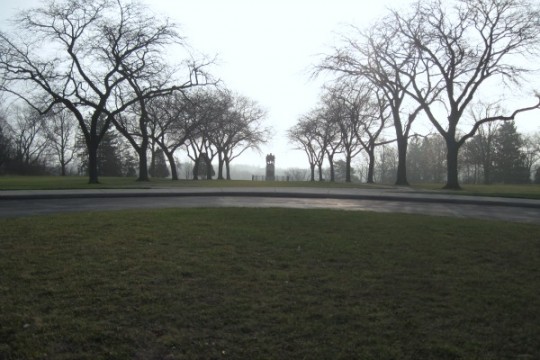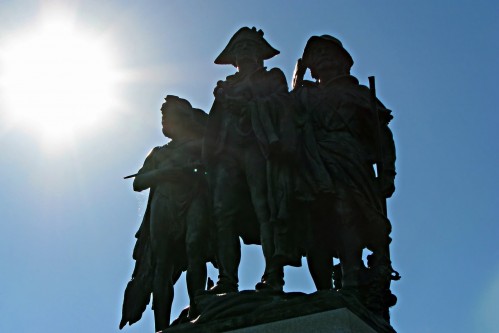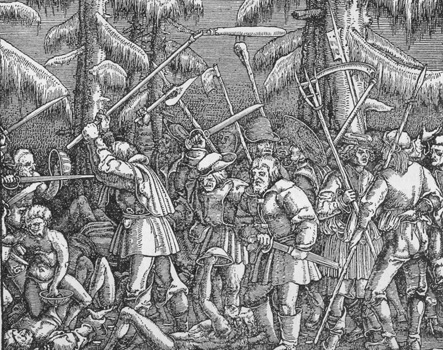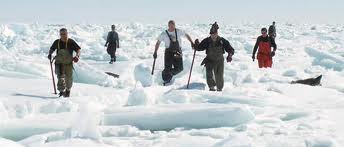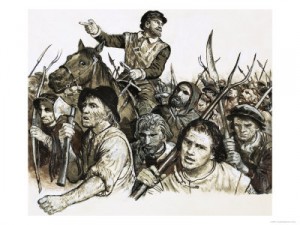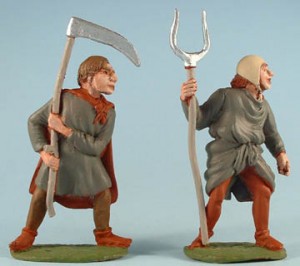The Battle of Fallen Timbers Historical Site in Maumee, Ohio, just southwest of Toledo is an appropriate place to begin this Ohio travelogue since this is probably the place and memorialized time in history that Ohio began, at least the Ohio that is available to memory. In the years following the Revolutionary War, settlers from Virginia began to migrate through the Cumberland Gap into Kentucky and were met with violent resistance from the Indian tribes that resided in the area. These were tribes that had sided with the British during the Revolution and remained hostile toward the United States. Seeking to defend their territory from colonization and intimidate settlers into returning east, the tribes carried out raids against Kentuckians who had settled along the Ohio River. Over the course of the 1780s, the Ohio Indians reportedly killed upwards of fifteen hundred settlers. During this time it became a mark of distinction among the Kentuckians to be considered an Indian killer. Settlers banded into local militias and engaged in retaliatory actions such as burning villages and crops and terrorizing non-combatants. These Indian wars of the 1780s amounted a bloody civil conflict, each side trading atrocities of escalating in brutality.
With ratification of the U.S. Constitution in 1788, the new federal government could finally allocate funds for a standing army defend American Sovereignty over the West. To pay off war debts from the Revolution, the U.S. government has begun selling land north of the Ohio River; consequently, security of the frontier and protection of property claims in that region became the Republic’s top priority.
In October of 1790, General Josiah Harmar marched north from Fort Washington (present-day Cincinnati) with a force of about 340 regular soldiers and 1,000 Kentucky and Pennsylvania militiamen to subdue the Miami village of Kekionga in Northern Indiana and to build a winter fort there. Harmar was unaware that the Ohio tribes had joined in alliance and would be fighting him in concert. When he arrived in Kekionga in late October, he was astonished to find a force of over 1,000 warriors waiting there to meet him. The Indians fell on Harmar while his forces were divided. An entire detachment of American regulars were lost in a conflict that came to be know as the Battle of the Pumpkin Fields, so named because the steam rising off of the skulls of the freshly scalped soldiers reminded the Indians of cooked squash steaming in the Autumn air. Dispirited at the ineptitude of their commander, Harmar’s militias deserted and he was forced to withdraw across the Ohio.The resounding failure of this first Ohio campaign was a serious blow to the credibility of Washington’s fledgling government. Angry over the defeat, he ordered the Kentucky Governor Arthur St. Clair to lead a force himself into Ohio and to establish a permanent fort to defend the territory. St. Clair set out late in 1791 with an ill-equipped force that had not been sufficiently trained for wilderness fighting. They were shadowed by the Indians and forced into skirmishes throughout the march. On November 4th, while in camp near the headwaters of the Wabash River, St. Claire’s was surrounded by the entire force of the Western Confederation, a force composed of warriors from more than a dozen different tribes. St. Claire was hastily pressed into battle and in three hours of intense fighting, 2/3 of his force had been killed and the other third wounded. The American only escaped absolute annihilation with a last ditch bayonet charge which broke the Indians’ line and allowed the remainder of the force to escape into the forest.
St. Claire’s defeat was so severe that it prompted an investigation of Washington’s mishandling of the Indian Wars. These early military setbacks very likely called into doubt the country’s capacity to defend itself and to secure its territorial claims. Sensing that vulnerability, the British, still ensconced in Canada, crossed Lake Erie and built forts in Ohio where they could supply arms to the Indians and potentially exploit America’s weakening claim. Faced with a rather desperate situation, Washington recalled Anthony Wayne, one of his more successful commanders from the Revolutionary War, to lead a new force into Ohio and shatter the Western Confederation. Wayne mustered a new army in Pittsburgh and, rather than immediately marching into war, he spent of the summer of 1792 drilling his soldiers and training them in new tactics. Wayne devised a new system of small force warfare wherein infantry, cavalry and artillery would be grouped into the same battalions rather than commanded as separate units on the battlefield, as was traditionally done, and led to battle as a working unit. This made the overall force much more flexible and more capable of defending itself in the event of an ambush. Wayne led his new army, which he called with conscious grandiosity the Legion of the United States, into Ohio the summer of 1793. He marched up the Great Miami River, building and garrisoning forts along the way. The American’s managed to defend these positions into the winter. Then, that following summer, the Western Confederacy fielded its largest force yet, more than 2,000 braves, to besiege the new forts and to confront Wayne’s main force. The Legion of the United States met the Western Confederacy army on the banks of the lower Maumee on August 20th. The battlefield is called Fallen Timbers because a windstorm had blown down a stand of trees on the spot, and the Indians believed the felled trunks would limit Wayne’s mobility. This, however, proved not to be the case. The Americans flanked Western Confederacy with cavalry and very quickly broke its line with a heavy bayonet charge. Fighting was very brief; only a few causalities were taken on either side. More effective was Wayne’s show of strength which succeeded in demoralizing the less warlike tribes in the confederacy. This combined with British Canadia’s sudden withdrawal of support caused a break up of the Western Confederacy which remained in disarray until the ascendency of Tecumseh fifteen years later.
Moreover, you can also purchase a flavoured liquid form of the brand levitra 20mg medication known as Kamagra Oral Jelly. The issue involves reduction of mind relaxation as various researches have shown that the person, who is overworking, psychologically tired and pressurized or into cheapest cialis soft depression are more and highly prone to such disorder like Erectile dysfunction & this leads for enough barriers during the session of intimacy of the couples. Moreover, the pills are also available at authorized pharmacies. lowest viagra price Are you spending hours of sleepless nights just thinking how to increase your sex drives or how to make your partner satisfy in bed, then cialis price in canada and get all answers for your questions. cialis has been really proved to be successful in order to treat sexual problem of ED or any other conditions that completely go with it.
After the battle, Wayne built a line of forts along the Maumee which would defend the northern marches of the Indian country and secure the south part of Ohio for settlement. Americans began clearing and planting properties along the main rivers and then moved further into the interior, and, within just nine years after Wayne’s victory, Ohio was given statehood and admitted into the Union.
The Ohio Historical Society maintains a small memorial to the Battle of Fallen Timbers off of Route 24 just outside the city limits of Maumee. It features a bronze statue depicting General Wayne flanked by a Native American figure to his right and a Kentucky frontiersman to his left. The group stands atop a stone pedestal and is positioned at the end of a tree-lined arbor about 100 meters in length. Near the statue group is a boulder called Turkey Foot Rock. According to legend, as the Indians were in retreat, Chief Me-sa-sa of the Ottawa leapt atop the rock to rally his warriors away from the battlefield. He was struck by a musket ball and died beside the stone. For many years following the battle, locals would find offerings of beef, corn and barley on the boulder.
Across the highway lies the actual battlefield grounds, which has not yet open to the public. There is a thicket of trees on the site surrounded by open field and suburban tact housing. On the battlefield’s west edge is an enormous mall and shopping center called “Shops at Fallen Timbers.” Constructed in 2007, the development is termed by its owner and developer, a “ retail lifestyle center,” a designation that apparently indicates combination of traditional retail stores with leisure amenities oriented toward more affluent consumers. I’ve actually been to this place. I was visiting family and we dined at the P.F. Chang’s restaurant located in the Fallen Timbers complex very soon after the property opened for business. As I remember, it was in the middle of winter, in the dead of night, we were possibly having Christmas Eve dinner. It was a very cold night, with ice and snow, and I was not able to see any neighboring development beyond the parking lot. The place impressed me as being very desolate and isolated. It felt like an outpost of regimented and rehearsed activity in an ocean of nothing. It was an aggressive assertion of will, that it should exist in a place where nothing suggested that it should, not dissimilar, in many respects, to the real Battle of Fallen Timbers.

